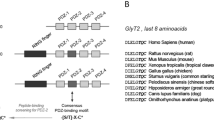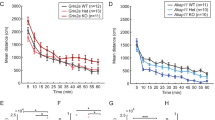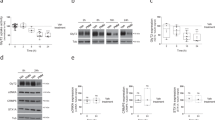Abstract
Hyperekplexia is a human neurological disorder characterized by an excessive startle response and is typically caused by missense and nonsense mutations in the gene encoding the inhibitory glycine receptor (GlyR) α1 subunit (GLRA1)1,2,3. Genetic heterogeneity has been confirmed in rare sporadic cases, with mutations affecting other postsynaptic glycinergic proteins including the GlyR β subunit (GLRB)4, gephyrin (GPHN)5 and RhoGEF collybistin (ARHGEF9)6. However, many individuals diagnosed with sporadic hyperekplexia do not carry mutations in these genes2,3,4,5,6,7. Here we show that missense, nonsense and frameshift mutations in SLC6A5 (ref. 8), encoding the presynaptic glycine transporter 2 (GlyT2), also cause hyperekplexia. Individuals with mutations in SLC6A5 present with hypertonia, an exaggerated startle response to tactile or acoustic stimuli, and life-threatening neonatal apnea episodes. SLC6A5 mutations result in defective subcellular GlyT2 localization, decreased glycine uptake or both, with selected mutations affecting predicted glycine and Na+ binding sites.
This is a preview of subscription content, access via your institution
Access options
Subscribe to this journal
Receive 12 print issues and online access
$209.00 per year
only $17.42 per issue
Buy this article
- Purchase on Springer Link
- Instant access to full article PDF
Prices may be subject to local taxes which are calculated during checkout




Similar content being viewed by others

References
Shiang, R. et al. Mutations in the α1 subunit of the inhibitory glycine receptor cause the dominant neurologic disorder, hyperekplexia. Nat. Genet. 5, 351–358 (1993).
Shiang, R. et al. Mutational analysis of familial and sporadic hyperekplexia. Ann. Neurol. 38, 85–91 (1995).
Rees, M.I. et al. Compound heterozygosity and nonsense mutations in the α1-subunit of the inhibitory glycine receptor in hyperekplexia. Hum. Genet. 109, 267–270 (2001).
Rees, M.I. et al. Hyperekplexia associated with compound heterozygote mutations in the β-subunit of the human inhibitory glycine receptor (GLRB). Hum. Mol. Genet. 11, 853–860 (2002).
Rees, M.I. et al. Isoform heterogeneity of the human gephyrin gene (GPHN), binding domains to the glycine receptor, and mutation analysis in hyperekplexia. J. Biol. Chem. 278, 24688–24696 (2003).
Harvey, K. et al. The GDP-GTP exchange factor collybistin: an essential determinant of neuronal gephyrin clustering. J. Neurosci. 24, 5816–5826 (2004).
Vergouwe, M.N. et al. Hyperekplexia-like syndromes without mutations in the GLRA1 gene. Clin. Neurol. Neurosurg. 99, 172–178 (1997).
Morrow, J.A. et al. Molecular cloning and functional expression of the human glycine transporter GlyT2 and chromosomal localisation of the gene in the human genome. FEBS Lett. 439, 334–340 (1998).
Roux, M.J. & Supplisson, S. Neuronal and glial glycine transporters have different stoichiometries. Neuron 25, 373–383 (2000).
Eulenburg, V., Armsen, W., Betz, H. & Gomeza, J. Glycine transporters: essential regulators of neurotransmission. Trends Biochem. Sci. 30, 325–333 (2005).
Supplisson, S. & Roux, M.J. Why glycine transporters have different stoichiometries. FEBS Lett. 529, 93–101 (2002).
Gabernet, L. et al. Enhancement of the NMDA receptor function by reduction of glycine transporter 1 expression. Neurosci. Lett. 373, 79–84 (2005).
Gomeza, J. et al. Inactivation of the glycine transporter 1 gene discloses vital role of glial glycine uptake in glycinergic inhibition. Neuron 40, 785–796 (2003).
Tsai, G. et al. Gene knockout of glycine transporter 1: characterization of the behavioral phenotype. Proc. Natl. Acad. Sci. USA 101, 8485–8490 (2004).
Gomeza, J. et al. Deletion of the mouse glycine transporter 2 results in a hyperekplexia phenotype and postnatal lethality. Neuron 40, 797–806 (2003).
Krogsgaard-Larsen, P., Frolund, B. & Frydenvang, K. GABA uptake inhibitors. Design, molecular pharmacology and therapeutic aspects. Curr. Pharm. Des. 6, 1193–1209 (2000).
Barker, E.L. & Blakely, R.D. Norepinephrine and serotonin transporters: molecular targets of antidepressant drugs. In Psychopharmacology—the Fourth Generation of Progress (eds. Bloom, F.E. & Kupfer, D.J.) 321–333 (Raven, New York, 1995).
Hahn, M.K. & Blakely, R.D. Monoamine transporter gene structure an polymorphisms in relation to psychiatric and other complex disorders. Pharmacogenomics J. 2, 217–235 (2002).
Hahn, M.K., Mazei-Robison, M.S. & Blakely, R.D. Single nucleotide polymorphisms in the human norepinephrine transporter gene affect expression, trafficking, antidepressant interaction, and protein kinase C regulation. Mol. Pharmacol. 68, 457–466 (2005).
Richerson, G.B. & Wu, Y. Role of the GABA transporter in epilepsy. Adv. Exp. Med. Biol. 548, 76–91 (2004).
Hahn, K.A. et al. X-linked mental retardation with seizures and carrier manifestations is caused my mutation in the creatine-transporter gene (SLC6A8) located in Xq28. Am. J. Hum. Genet. 70, 1349–1356 (2002).
Rosenberg, E.H. et al. High prevalence of SLC6A8 deficiency in X-linked mental retardation. Am. J. Hum. Genet. 75, 97–105 (2004).
Horiuchi, M. et al. Surface-localized glycine transporters 1 and 2 function as monomeric proteins in Xenopus oocytes. Proc. Natl. Acad. Sci. USA 98, 1448–1453 (2001).
Yamashita, A., Singh, S.K., Kawate, T., Jin, Y. & Gouaux, E. Crystal structure of a bacterial homologue of Na+/Cl−-dependent neurotransmitter transporters. Nature 437, 215–223 (2005).
Roux, M.J. et al. The glial and the neuronal glycine transporters differ in their reactivity to sulfhydryl reagents. J. Biol. Chem. 276, 17699–17705 (2001).
Mager, S. et al. Steady states, charge movements, and rates for a cloned GABA transporter expressed in Xenopus oocytes. Neuron 10, 177–188 (1993).
Mager, S. et al. Ion binding and permeation at the GABA transporter GAT1. J. Neurosci. 16, 5405–5414 (1996).
Ohno, K. et al. The neuronal glycine transporter 2 interacts with the PDZ domain protein syntenin-1. Mol. Cell. Neurosci. 26, 518–529 (2004).
Horiuchi, M., Loebrich, S., Brandstaetter, J.H., Kneussel, M. & Betz, H. Cellular localization and subcellular distribution of Unc-33-like protein 6, a brain-specific protein of the collapsing response mediator protein family that interacts with the neuronal glycine transporter 2. J. Neurochem. 94, 307–315 (2005).
Tunnicliff, G. Membrane glycine transport proteins. J. Biomed. Sci. 10, 30–36 (2003).
Acknowledgements
We thank E.A. Peeters and K. Braun for referrals of research participants. This work was supported by grants from the Medical Research Council (UK) to R.J.H. and T.G.S., from the Neurological Foundation for New Zealand and Auckland Medical Research Foundation to M.I.R. and from the Fédération pour la Recherche sur le Cerveau and the Association Française contre les Myopathies to S.S.
Author information
Authors and Affiliations
Corresponding authors
Ethics declarations
Competing interests
The authors declare no competing financial interests.
Supplementary information
Supplementary Fig. 1
Sequencing panel representing the pathological hyperekplexia variants detected in SLC6A5 (PDF 479 kb)
Supplementary Fig. 2
Electrophysiological analysis of GlyT2 mutants in NG108-15 cells (PDF 381 kb)
Supplementary Table 1
Oligonucleotide primers for analysis of the human GlyT2 gene (SLC6A5) and amplification of human GlyT2 cDNAs (PDF 85 kb)
Supplementary Table 2
Patient/mutation detection rates in hyperekplexia candidate genes (PDF 109 kb)
Supplementary Table 3
Single nucleotide polymorphisms detected in the coding regions of the human GlyT2 gene (SLC6A5) (PDF 116 kb)
Supplementary Note
Detailed clinical reports for affected SLC6A5 patients and relatives (PDF 134 kb)
Supplementary Video 1
Patient 6 Video. When placed in water for his bath, he developed rapid quivering of his limbs, with a staccato grunting cry, followed by silence and intense stiffening in a semi-flexed posture. He became deeply cyanosed and had anoxic non-epileptic seizures in the form of spasms, together with forcible urination. Thereafter he had a grey moribund appearance. When an episode was induced with EEG and ECG leads attached, EMG “spikes” appeared on EEG channels overlying muscle and on the ECG channel, either as repetitive giant potentials in the “clonic” phase or as closely spaced giant muscle potentials in the “tonic” phase. Meanwhile the EEG became isoelectric, and the ECG showed junctional bradycardia, reflecting severe syncope. (MPG 18703 kb)
Rights and permissions
About this article
Cite this article
Rees, M., Harvey, K., Pearce, B. et al. Mutations in the gene encoding GlyT2 (SLC6A5) define a presynaptic component of human startle disease. Nat Genet 38, 801–806 (2006). https://doi.org/10.1038/ng1814
Received:
Accepted:
Published:
Issue Date:
DOI: https://doi.org/10.1038/ng1814
This article is cited by
-
SLC gene mutations and pediatric neurological disorders: diverse clinical phenotypes in a Saudi Arabian population
Human Genetics (2022)
-
Calcium-Dependent Regulation of the Neuronal Glycine Transporter GlyT2 by M2 Muscarinic Acetylcholine Receptors
Neurochemical Research (2022)
-
The presynaptic glycine transporter GlyT2 is regulated by the Hedgehog pathway in vitro and in vivo
Communications Biology (2021)
-
Advances in hyperekplexia and other startle syndromes
Neurological Sciences (2021)
-
E3 ubiquitin ligases LNX1 and LNX2 are major regulators of the presynaptic glycine transporter GlyT2
Scientific Reports (2019)


